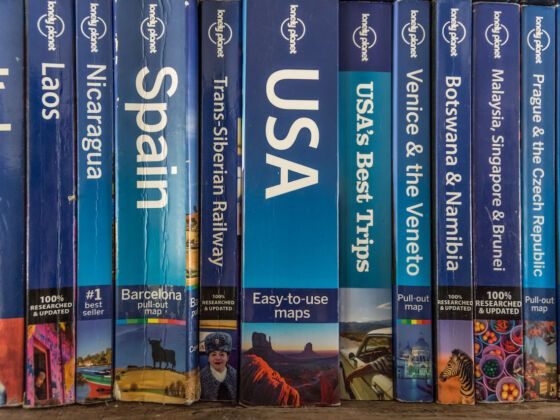AS THE BUS PULLED INTO the station in Jaisalmer I peered through the rotting curtains hanging limply by my window. All I could see in the early morning mist was a maelstrom of violence, as two or three lines of hotel owners and touts were being beaten back by the police swinging their wooden lathis. As soon as I stepped off, a deluge of sweating, shouting bodies, ignoring the blows raining down, broke through the levee and surged forward. It was bedlam and I began to wish I had come with an address or the name of somewhere to stay.

Someone grabbed my arm and pushed a dirty, dog-eared business card into my hand, “I’m in your Bible. Go on, look me up.”
“My bible?”
“Yes, yes. Your Bible.” He nodded at the couple pinned to the side of the bus, gripping their Lonely Planet Guide to India.
I had had one of those. A friend had given me a second-hand copy but it had been like a brick taking up half of my backpack. And remembering what it had been like traveling through South East Asia, Bali, Australia and Hong Kong carting around endless guide books that I had never really used, I had thrown it in a bin somewhere on the outskirts of Bengaluru in Karnataka after the first week. I had decided I wanted an adventure, to discover India and find my way own around. So I had bought a map of India, and then a state or city map when I arrived somewhere new.
This is what I learned along the way.
1. I survived.
Long before I ever thought about packing a rucksack people had been traveling around the world. And, of course, some had written books on it so that other people could follow in their tracks. Since then, India, indeed the world, has become much smaller and more accessible.
2. I interacted with people more.
This wasn’t the first time locals were surprised I wasn’t carrying a copy of the Lonely Planet with me. “How do you get around?” I was once asked at the train station.
“I talk to people.” Locals, hotel owners, street vendors, train staff, other travelers. Simple as that.
3. I found a few gems of my own. I found a few dives too.
One of the best pieces of advice someone gave me before I left on my journey was, “Follow the locals. Eat where they eat. Eat where it’s busy.” I ate some of the best and cheapest food this way. Often I would meet someone there that could point out a decent local hotel to spend a night or two. More often than not it was cheap, too, and more than suited my needs. I came across some real dives too, but it felt like it was my India.
4. I honed my traveler’s instinct quicker.
I began trusting myself more. If I didn’t like the feel of somewhere or someone I walked away with confidence. When I got to a new town, I could sniff out the people I could trust. If they weren’t around, I would find the nearest chai-wallah and wait. They would turn up sooner or later.
5. There’s a lot more to a place than the usual tourist attractions.
Listings in guidebooks ended up becoming a litany of things to tick off. Going in blind, towns and cities came alive and traveling became a trip into the unknown. More often than not, when I spent long enough somewhere, I would end up passing any major sights anyway and discovered some not-so-popular treasures too.
6. It can be fun to just let go.
To choose a place just because I liked the name on a map, to pull into town with no idea of what’s there, indeed, if there’s anything at all was a thrilling mix of excitement and uncertainty. To set out with nothing in mind except wandering and exploring opened me up to marvelous discoveries and chance encounters.
7. My travel guides became snatches of conversation and scribbled notes on a piece of paper.
You are not alone, there is always someone, another free spirit, a like-minded traveler, with a name and address written on a page torn out of a notebook or an empty cigarette packet. Places that aren’t in any guide books, places that are well worth the visit.